Osmium's extreme density (22.59 g/cm3) offers exceptional strength but is impractical for aircraft manufacturing compared to aluminum's low density (2.70 g/cm3) and high corrosion resistance, which enhance fuel efficiency and structural durability. Aluminum's widespread use in aerospace alloys like 7075 provides an ideal balance of strength-to-weight ratio critical for performance and safety.
Table of Comparison
| Property | Osmium | Aluminum |
|---|---|---|
| Density | 22.59 g/cm3 (highest natural density) | 2.70 g/cm3 (lightweight) |
| Tensile Strength | ~400 MPa | 110-570 MPa (varies by alloy) |
| Corrosion Resistance | Excellent (highly stable) | Good (requires alloying and treatment) |
| Cost | Extremely high (rare and precious) | Low (abundant and economical) |
| Workability | Poor (brittle and hard to machine) | Excellent (easy to form and machine) |
| Thermal Conductivity | 87 W/m*K | 235 W/m*K |
| Suitability for Aircraft Manufacturing | Limited (excessive weight and cost) | Highly suitable (lightweight and strong) |
Introduction to Osmium and Aluminum in Aircraft Manufacturing
Osmium, a dense and corrosion-resistant transition metal, is seldom used in aircraft manufacturing due to its scarcity and high cost, while aluminum remains the primary material owing to its lightweight, high strength-to-weight ratio, and excellent corrosion resistance. Aluminum alloys, particularly 2024 and 7075 grades, dominate aircraft structures, offering a balance of durability, weldability, and ease of fabrication that meets stringent aerospace standards. The stark contrast in material properties and economic feasibility positions aluminum as the preferred choice for aircraft manufacturing over osmium.
Material Properties Comparison: Osmium vs Aluminum
Osmium exhibits an exceptionally high density of approximately 22.59 g/cm3, making it one of the densest naturally occurring elements, while aluminum's density is significantly lower at about 2.70 g/cm3, providing a lightweight advantage crucial for aircraft efficiency. In terms of mechanical properties, osmium offers superior hardness and wear resistance but lacks the ductility and tensile strength characteristics of aluminum alloys, which are engineered for enhanced strength-to-weight ratios and corrosion resistance in aerospace applications. Thermal conductivity and oxidation resistance further favor aluminum, contributing to its widespread use in aircraft manufacturing, whereas osmium's brittleness and high density limit its practical application despite its notable durability.
Weight and Density Implications for Aircraft Design
Osmium's density at approximately 22.59 g/cm3 far exceeds aluminum's 2.70 g/cm3, making it significantly heavier for equivalent volumes. This extreme weight advantage of aluminum is crucial in aircraft manufacturing, where minimizing weight directly improves fuel efficiency and flight performance. Selecting aluminum alloys allows designers to optimize structural integrity while maintaining lightweight frameworks essential for aerodynamic efficiency and cost-effective operation.
Strength and Durability: Evaluating Performance
Osmium exhibits exceptional density and hardness, contributing to superior strength and wear resistance compared to aluminum, which is lightweight and offers moderate tensile strength ideal for reducing aircraft weight. However, osmium's brittleness and scarcity limit its practical application in aircraft manufacturing, whereas aluminum alloys provide an optimal balance of strength, durability, and corrosion resistance critical for structural components. The evaluation of performance highlights aluminum's widespread use due to its favorable strength-to-weight ratio and long-term durability, while osmium remains impractical despite its impressive material properties.
Corrosion Resistance and Longevity in Aerial Environments
Osmium exhibits exceptional corrosion resistance due to its dense atomic structure and inert chemical properties, making it highly durable in aggressive aerial environments. Aluminum, while lightweight and widely used in aircraft manufacturing, is more prone to corrosion unless treated with protective coatings or alloys. The superior longevity of osmium in harsh atmospheric conditions offers potential advantages in aircraft components exposed to extreme environmental stress, but its high density and cost limit practical applications compared to aluminum.
Cost and Resource Availability of Osmium and Aluminum
Osmium is extremely rare and scarce, making its cost prohibitively high for widespread use in aircraft manufacturing compared to aluminum, which is abundant and relatively inexpensive. Aluminum's availability from extensive global reserves ensures stable supply chains and lower material costs, whereas osmium's limited extraction primarily from platinum ores results in limited availability and significantly higher prices. Consequently, aluminum dominates the aerospace industry due to its cost-effectiveness and resource accessibility.
Manufacturing Processes and Fabrication Challenges
Osmium's extreme density and brittleness present significant fabrication challenges, making it unsuitable for conventional aircraft manufacturing processes like casting or machining. Aluminum, favored for its lightweight and ductility, enables efficient extrusion, rolling, and welding techniques critical for producing complex airframe components. The manufacturing processes of aluminum alloys reduce production costs and enhance structural integrity, contrasting sharply with osmium's limited workability and high material handling risks.
Environmental Impact and Sustainability Considerations
Osmium, a dense and rare platinum-group metal, poses significant environmental challenges due to its limited availability and energy-intensive extraction processes, making it less sustainable for widespread aircraft manufacturing. Aluminum, by contrast, is abundant, highly recyclable, and requires less energy for production, contributing to a lower carbon footprint and greater sustainability in aerospace applications. The extensive recycling infrastructure for aluminum significantly reduces environmental impact compared to osmium, supporting long-term ecological balance in aircraft manufacturing.
Industry Adoption: Historical and Current Trends
Osmium's extreme density and rarity limit its use in aircraft manufacturing despite excellent hardness and corrosion resistance, while aluminum's lightweight, high strength-to-weight ratio, and cost-effectiveness have made it the industry standard since the early 20th century. Historically, aluminum alloys like 2024 and 7075 have dominated airframe and fuselage construction, enabling fuel efficiency and structural performance that osmium cannot economically match. Current trends focus on enhancing aluminum's properties through advanced composites and alloys, as osmium remains impractical for large-scale aerospace applications due to its scarcity and high cost.
Future Prospects: Innovations and Emerging Research
Osmium's exceptional density and hardness offer potential for ultra-compact, high-strength components in specialized aircraft applications, while aluminum remains preferred for its lightweight and cost-efficiency. Emerging research explores osmium-based alloys and nanocomposites to enhance structural resilience and thermal stability beyond aluminum's current limits. Innovations in additive manufacturing and materials science could enable osmium's integration into aerospace design, transforming future aircraft performance and durability.

Infographic: Osmium vs Aluminum for Aircraft Manufacturing
 azmater.com
azmater.com